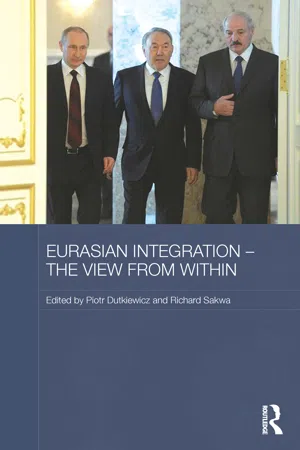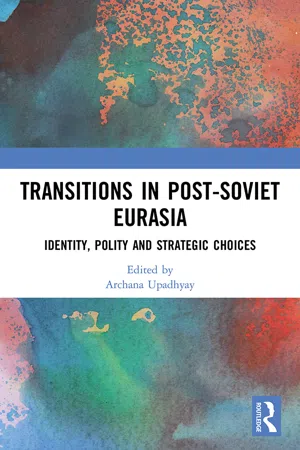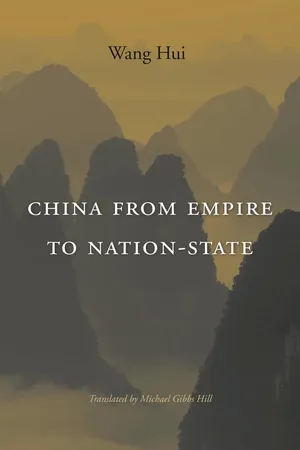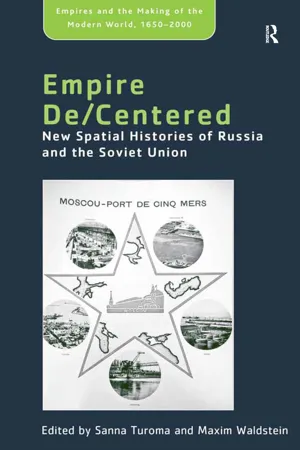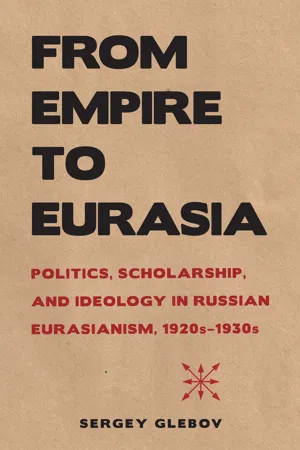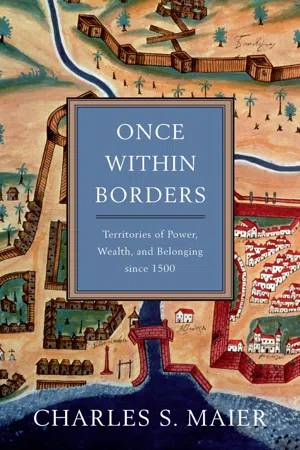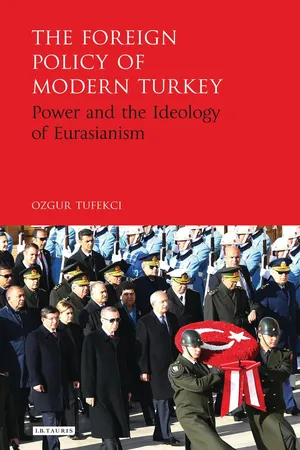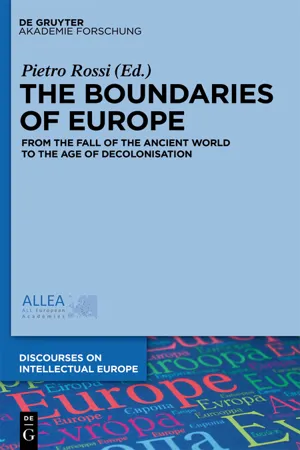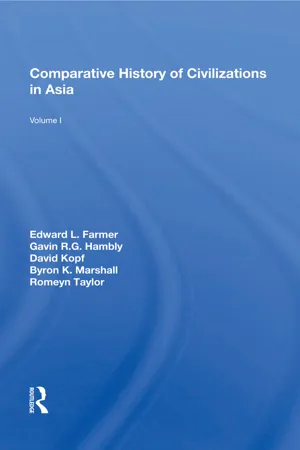History
Eurasian Empire
The Eurasian Empire refers to a historical entity that encompassed territories in both Europe and Asia. It is often associated with the vast and diverse empires that have held sway over these regions, such as the Mongol Empire and the Ottoman Empire. The concept highlights the interconnectedness of these two continents through political, cultural, and economic exchanges.
Written by Perlego with AI-assistance
Related key terms
10 Key excerpts on "Eurasian Empire"
- eBook - ePub
- Piotr Dutkiewicz, Richard Sakwa, Piotr Dutkiewicz, Richard Sakwa(Authors)
- 2014(Publication Date)
- Routledge(Publisher)
The ideological connotations behind this concept are clear to some countries in this region, but the concept of Eurasia is constructed by both those inside and outside this region, used to denote both self and other. This term itself has a high degree of flexibility; the idea of Eurasia has always been mobile. Within this region, the rise and decline of trade networks provided the important impetus for the progress of civilization (see Table 17.1). Table 17.1 The four waves of Eurasian trade Eurasian exchanges Routes Which way First period: first–third centuries Sea and land Roman Empire – West Asia – India – China Second period: eleventh–thirteenth centuries Sea and land trade (Silk Road) More-frequent trade between the Arab world, South Asia and East Asia; Europe was on the verge of Eurasian trade Third period: sixteenth–nineteenth centuries Mainly sea Intensive interregional trade; Europe, West Asia – India – South-East Asia – East Asia. European competitiveness was still relatively weak, making up the deficit by passing silver bullion Fourth period: present day Mainly through sea, much less over land; air, long-distance telecommunications Initially more from Europe to Asia; increasingly also in the opposite direction and within Eurasian landmass; significant boost as the Soviet Union broke up; huge boost with China rising as an economic superpower Source : A. Libman and E. Vinokurov, Eurasian Integration: Challenges of Transcontinental Regionalism (Basingstoke: Palgrave Macmillan, 2012). From Table 17.1 we can see that Eurasia was once treated as a prosperous region along the Silk Road and was deeply connected to the world system. Later, with the rise of the ‘maritime trade routes’, Eurasia, once an important hub on the Silk Road, was no longer significant and gradually became isolated from the outside world - eBook - ePub
Transitions in Post-Soviet Eurasia
Identity, Polity and Strategic Choices
- Archana Upadhyay, Archana Upadhyay(Authors)
- 2021(Publication Date)
- Routledge India(Publisher)
This term is a political construction of the geographical boundaries of the 14 former republics of the Soviet Union and is closely linked with Russia’s economic and security interests. Most importantly, more than 25 million ethnic Russians reside in the former Soviet republics and Russia feels responsible for their well-being. Moreover, any flare-up in the borderlands has the potential to destabilize and jeopardize the power balance in the entire region. In the wider discourse on Eurasia, what particularly stands out is the centrality of the ‘national question’ both in the theoretical and practical sense and its role in the geopolitical and social forecasts that offer different perspectives on the formation of a new worldview. It is significant that in each of the visions of Eurasia, co-existence, rather than an ‘isolated geopolitical existence’, based on the principles of legal and civic life is perceived as a more fruitful option for the region. As a century-old idea, the ideological relevance of the Eurasian geopolitical system, complete with its political, social, economic and ethno-cultural ideas, has been affirmed by many subsequent sociohistorical processes and events. Although the concept has branched into different forms, each form holds its particular view on the distinct geopolitical identity of the region stretching across Asia and Europe and including other constituents that together make the Eurasian landscape. 48 The Eurasian world is not antithetical to national postulations (Slavic, Russian, Mongolian, Caucasian, Kazakh), ethnic (Slavic or Turkic) or religious (Islamic, Christian or Buddhist) or to political associations - eBook - ePub
Asia in Western and World History: A Guide for Teaching
A Guide for Teaching
- Ainslie T. Embree, Carol Gluck(Authors)
- 2015(Publication Date)
- Routledge(Publisher)
the famous lines of Vergil’s Aeneid VI. 851–53: “Remember, Roman, that these shall be your arts—to rule the nations by your power and to impose the custom of peace, to treat the humbled with forbearance, and to war down the arrogant.”). Often it takes the form of a more or less complex and universal ideology, frequently religious in origin. This can range from the relatively straightforward conviction that one’s own god is more powerful than other gods and authorizes the winning of universal rule—as in the case of the Assyrians with their god Ashur—to such relatively idealistic goals as the incorporation of all peoples into a single social or religious structure, such as the gradual extension of Roman citizenship in the Roman Empire to cover virtually all free inhabitants by the third century C.E., or the missionary zeal of Islam in the seventh and subsequent centuries C.E. A common factor seems to be that the ideal or principle which helps to motivate, organize, or unify an empire or imperial people is generally seen as somehow life-enhancing, and thus as a positive force in human affairs worth the expending of effort and blood, and the sacrifice of individual or local autonomy. A HISTORICAL SUMMARY To speak or write simply of “Asia,” as if this vast region constituted a single cultural-political continuum, would be a mistake. In the ancient period, as in many respects still today, Asia consists of at least four major regions largely independent of each other in terms of cultural or any other interchange. One such region is western Asia, from the Hindu Kush in the east to the Mediterranean basin in the west, and from the Black, Caspian and Aral seas in the north to the Indian Ocean in the south. Despite the many and important contacts with the East, this region has tended to look westward and be linked more closely with the history of Europe and North Africa than with that of the rest of Asia - eBook - ePub
- Hui Wang, Michael Gibbs Hill, Michael Gibbs Hill(Authors)
- 2014(Publication Date)
- Harvard University Press(Publisher)
(minzu)?After his systematic inquiry into the meanings of the term “empire,” Dominic Lieven concluded:Over the last two millennia the word “empire” has meant many different things to different people from different countries at different times. Indeed it has often had different meanings to people from the same country at the same time. Statesmen and political thinkers have on occasion noted the word’s ambiguity, themselves deliberately using it in different contexts to convey a variety of meanings.9This specialist in the history of the Russian Empire and in the comparative history of empires gives us a sketch of the rich and ambiguous history of the concept of empire and, against a global backdrop, describes the rise and fall of various major empires. The concept of empire was still linked with such concepts as prosperity and strength at the beginning of the twentieth century; its devaluation took place only during a distinct period in which Nazi Germany appropriated the concept of empire and when, during the Cold War, Western nations regularly used the term to castigate the Soviet Union. Why, however, did Western societies’ repudiation of the Nazis and the Soviet Union rely on the condemnation of the concept of “empire”? In my opinion, this popular usage is based on a deeper intellectual background: in the categories of traditional political economy in the nineteenth century and in twentieth century social sciences, a connection had already been firmly established between empires’ expansionism and despotism.10 - eBook - ePub
Empire De/Centered
New Spatial Histories of Russia and the Soviet Union
- Maxim Waldstein, Sanna Turoma(Authors)
- 2016(Publication Date)
- Routledge(Publisher)
exemplars of what these interpretations and explanations based on decentering traditional perspectives and the “de-provincialization” of continental empires and Russia might look like. The chapters are sorted not chronologically or by region but thematically and methodologically. The first two sections are composed of the pieces that explore the entanglements between empire and space in the Russian intellectual tradition, in the works of the nineteenth- and twentieth-century Russian philosophers, economists, linguists, historians, and geographers. The contributors to the third section apply social-scientific perspectives to explore “imperial” and “spatial” aspects of various types of social interactions, public discourses, and academic debates. The final section explores a variety of ways of representing empire and imperial spatiality in literature, art, and popular media.An Outline of the Contributions
The volume starts by introducing a chapter in Russian intellectual history that produced the political movement of Eurasianism and its unique doctrine of empire and space. Founded in the post-revolutionary years by émigré scholars, Eurasianism surfaced again in the late Soviet period and gained currency in Russia in the 1990s after the disintegration of the Soviet Union. In its classic version Eurasianist ideology opposed European modernity and cultural colonialism, whose influence the founders saw as having led to the October Revolution. In an effort to rethink Russian Empire and its role in the new post-revolutionary world, they hailed the future of Russia–Eurasia as a distinctive empire-civilization and, simultaneously, super-ethnic nation, the leader of colonized people.58Eurasianist thinkers pioneered a number of “decentering” strategies in their work—for example, they focused on the Eurasian imperial experience that seemed aberrant and marginal within the framework of the then dominant Eurocentric perspectives, and, in analyzing this experience, they moved off-center, from imperial centers to peripheries and borderlands, from the capitals to the steppe. By focusing on the heterogeneity, or “federalism,” of Eurasian space and the hybridity of the cultural identities that this space engenders, Eurasianists legitimized Russian empire and its characteristic spatiality as a theoretically consequential object of study. Yet, they also celebrated Eurasian spatiality as a basis for their brand of Russian “imperial nationalism” and the Sonderweg theory. In effect, the decentering potential of their studies remained underexplored and even undercut by the effective reversal to more traditional patterns of thought.59 - eBook - ePub
NIU Series in Slavic, East European, and Eurasian Studies
Politics, Scholarship, and Ideology in Russian Eurasianism, 1920s–1930s
- Sergey Glebov(Author)
- 2017(Publication Date)
- Northern Illinois University Press(Publisher)
What had begun as a project of inclusion of different peoples in the common historical process ended as a celebration of Russian colonial expansion and imperialism. 201 As he argued, with the Russian subjugation of Turkestan in the 1860s, the firm and final political unity of Eurasia was achieved and the periodic change of Eurasian rhythms had ended. As Vernadskii put it, “history merged with modernity.” 202 Although Eurasianist historical views included historical relativism and a criticism of Eurocentrism, their focus remained on the holistic unity of Eurasia underwritten by geographical determinism. In Eurasianist conceptions of history, non-Russian populations featured minimally, except for the Mongols. The latter, though, functioned either as a factor that underscored Russia’s national specificity vis-à-vis Europe and the West, or, following nineteenth-century nationalist historiography, as a simple mechanical factor in the emergence of the Russian national state. The Eurasianist attempt to create a new “Eurasian” history was ultimately futile because they failed to produce an alternative to the nation- and state-centered narrative of nineteenth-century historians, so that the subject of their history essentially merged with “the Russian people” predestined to occupy the national territory of Eurasia. The subject of the historical process as viewed by the Eurasianists remained the same as that in the histories of the great nineteenth-century historians. - eBook - ePub
Once Within Borders
Territories of Power, Wealth, and Belonging since 1500
- Charles S. Maier(Author)
- 2016(Publication Date)
- Belknap Press(Publisher)
limes marked by a river or a mountain ridge or a formidable wall, is rarely fulfilled in a vigorous empire. How can it be when imperial dreams call for continuing expansion! And there, where borders are less clear-cut and military or proconsular authority less circumscribed—whether because passage at sea is essential, or imperial claims extend upriver into vast forest realms of the interior, or because tribal confederations rather than organized ongoing states confront the metropole’s expansionary ambitions—the space of empire prevails and its edge is always a restless zone, prone to violence and contested legal claims. Size was the reward for unrest at the frontier. Size mattered; territorial extension remained compelling and fascinating both for contemporaries and those who followed. Empire builders were both megalomaniac and awesome. They would conquer long-standing peoples and empty lands alike. As Christopher Marlowe had Tamburlaine (Timur) declare to his betrothed:Were Egypt Jove’s own land, Yet would I with my sword make Jove to stoop. I will confute those blind geographers That make a triple region in the world, Excluding regions which I mean to trace, And with this pen [reduce them to a map, Calling the provinces, cities, and towns,After my name and thine, Zenocrate.…We mean to travel to th’ antarctic pole, Conquering the people underneath our feet,And be renown’d as never emperors were.21Epochs of Empire
There is a time as well as space for empires. They possess typical temporal trajectories as well as territorial patterns. Individual empires, historical comparison suggests, require ruthless vigor, conquest, and reform to become established and notable. Then they excite rivals on the margins; their elites absorb revenues on the local level that are needed by the central administration; imperial succession produces repeated crises, contestation, and often rebellion. No wonder their vicissitudes encourage grand theories about rise and fall, whether Mediterranean notions of fortuna, Ibn Khaldun’s sense of Nomadic inner softening, Marxist-derived ideas about the exhaustion of surplus value, or Paul Kennedy’s notion of imperial overstretch. The historical and social-science explanations find equivalents in poetry, novels, and painting—for instance, Thomas Cole’s cycle of canvases created in the mid-nineteenth century. Whether historical or aesthetic, these are meditations about the rise and fall of individual empires.Traditional histories of imperial expansion also propose a model of successive hegemonic bids and their ultimate defeat. The German historian Ludwig Dehio wrote a brief classic that treated Philip II of Spain, Louis XIV, Napoleon, and Hitler as case studies of successive megalomaniacs cut down to size by the opposing coalitions their ambitions conjured up.22 - eBook - ePub
The Foreign Policy of Modern Turkey
Power and the Ideology of Eurasianism
- Ozgur Tufekci(Author)
- 2017(Publication Date)
- I.B. Tauris(Publisher)
CHAPTER 2 EURASIANISM: AN IDEOLOGICAL REVIVAL IntroductionRussia's intellectual circles have spent a significant amount of time determining Russia's place in the world. Particularly, these investigations reached their peak during the cataclysmic times of the Russian Revolution, World War I, the collapse of the USSR (The Union of Soviet Socialist Republics), etc. Both Classical Eurasianism and Neo-Eurasianism came out in such times as a conclusion to seeking a historical, geopolitical and cultural identity along with other nationalist movements.Nowadays, the term “Eurasianism” is synonymous with the term “Neo-Eurasianism”, although the latter represents different perspectives. To understand and assess Eurasianism thought from a holistic perspective, its background should be known and understood. For instance, under which conditions has it been developed? What was the rationale behind it? When was it brought about by its supporters? That is why the whole background of Eurasianism, its fathers and their goals from the early days of the twentieth century until present time need to be revealed for the purpose of providing a broad review of Eurasianism as the groundwork to evaluate the discourses of Eurasianism in contemporary Turkish politics. And then, the Eurasianism ideology needs to be briefly compared with pan-Slavism, as it is one of the ideologies which is confused most with the ideology of Eurasianism.Classical Eurasianism: A Historical Context, Emergence and PrinciplesIn Ancient Greece, the earth was divided into three separate pieces of land; Europe, Asia and Africa. The boundaries were waterways. For instance, the Mediterranean Sea was the boundary between Africa and Europe; the Nile was the boundary between Africa and Asia.1 While the boundaries, which separate Africa from Europe and Asia, were clear, there was no certain boundary between Europe and Asia. Whereas this is one of the geographical divisions of the world, there are other claims, which divide the world. For instance, Herodotus defines Europe in another way. According to him, “Europe has no independent existence, since it is only a part of Eurasia, which has no real internal boundaries of its own.”2 - eBook - ePub
- Pietro Rossi, Pietro Rossi(Authors)
- 2015(Publication Date)
- (Publisher)
Alberto Masoero Russia between Europe and Asia 1 An Empire with Uncertain Boundaries The transcontinental location of the Russian state is a constant factor throughout its history. It fostered a multiplicity of religious, cultural and institutional relations, largely spontaneous and pluridirectional, and not necessarily implying a clear dichotomy between East and West. After all, Europe and Asia meant different things in different centuries. Like a sponge, Russia absorbed its military vocabulary from German and the word chay for tea – the second most popular national drink – from Mandarin Chinese. This intermediate position affected the evolution of its borders, but also influenced representations of national identity and the ideology of the state. In the sixteenth century the Tsardom of Russia began its eastward expansion by conquering the Tatar states of Kazan and Astrakhan, and to some extent it inherited the legacy of Mongol rule. It consolidated its power in the West, resisting the interference of the Polish-Lithuanian Commonwealth, a more prestigious and powerful state at the time. The Tsar would also, after the partitions of Poland in the eighteenth century, claim the title of King of Poland. The centuries-old process of territorial expansion, directed towards different regions of Europe and Asia at different times, encountered its main setbacks during periods of profound political, social and economic crisis, accompanied by significant losses of territory and by discontinuities in dynasties and in the form of the state - eBook - ePub
- Edward L. Farmer(Author)
- 2019(Publication Date)
- Routledge(Publisher)
The ephemeral political integration of Eurasia under the Mongols was preceded by several developments tending towards a community of civilizations. The spread of the universal religions had created a measure of cultural and religious community that survived regional fragmentation within and among the civilizations. Overland and maritime trade generated mobile, cosmopolitan, commercial classes able to forge economic and, later, political links among the civilizations. Our own era of global politics was prefigured by the early attempts at high-level political cooperation, as between crusading Europe and the imperialist Mongols. The Mongol era was followed by that of the early modern empires, the subject of the following chapter. The Ottoman and Safavid empires in West Asia, the Mughuls in South Asia, Ming China, and Tokugawa Japan all were in some degree products of the disintegration of the Mongol empire and institutionally and culturally influenced by it. One might add Czarist Russia to the list, if this study were not limited to non-European Eurasia.The processes will be discussed in three main categories: first, the formation of a community of civilizations under the aspects of economy, culture, and politics; second, the formation of hybrid barbarian-civilized empires, in which we shall reexamine and enlarge upon processes of military and political interaction that have frequently been noted before; third, the processes associated with the breakup of the Mongol empire.Formation of a Eurasian Community of Civilizations
a. TradeIn the case of trade involving people of several different civilizations, ail obtain goods that would otherwise be scarce or nonexistent in their own regions. They are to this extent enriched in their material culture. It should be borne in mind, however, that this gain was usually enjoyed in this period by relatively restricted classes of people; the high cost of land, and even sea, transport limited goods in trade to those having a high ratio of value to weight and these were of necessity what we might today call luxury goods. Cultural consequences of such trade might include the adoption by a participating civilization of new forms of production as a means of lowering the costs of goods once available only by trade. The adoption of silk cultivation in Syria in the sixth century a d, for example, broke the East Asian monopoly. Moreover, trade in exotic goods did, however vaguely, communicate an awareness to the users of their place of origin, as reflected in the fact that at first Bactrian middlemen, and later the Chinese, were long known in the West as Seres, or "The Silk People." Of even greater importance is the fact that trade generated merchant classes, and these merchants, as dealers in luxury goods, were naturally in association with the wealthy and powerful in the several societies in question. By their wide-ranging contacts and by their skills—including organization, record keeping, economic calculation, knowledge of geography—they were well suited to the service of empire builders, who had a particular interest in being freed of the necessity of having to recruit administrators from the populations they had conquered.
Index pages curate the most relevant extracts from our library of academic textbooks. They’ve been created using an in-house natural language model (NLM), each adding context and meaning to key research topics.
